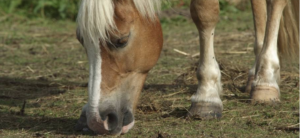 Mudbound: Feeding Horses in Muddy Pastures. When it comes to horse care, mud makes everything harder. How can horse owners deal with sloppy mud and still provide wholesome meals to their horses?
Mudbound: Feeding Horses in Muddy Pastures. When it comes to horse care, mud makes everything harder. How can horse owners deal with sloppy mud and still provide wholesome meals to their horses?
Here are some tips:
Keep hay off the ground
That’s not as easy as it sounds, is it? In a perfect world, every horse will consume every stem and every leaf of every flake of hay ever offered. In reality, horses are prone to wasting hay. When it’s muddy, it seems the waste is even more abundant. What to do? Hay feeders that stand off the ground are one option. Horses will yank hay from these feeders, sometimes vigorously, so some hay still hits the ground, but less is wasted. Some of these feeders can hold more than one bale of hay, which can make feeding multiple horses more efficient.
For owners that feed round bales, specially designed feeders can keep hay tidy. Be sure to use feeders intended for horses. Feeders engineered for cattle are sometimes not appropriate for horses. Because of height differences between species, small horses and ponies can become trapped in them.
One resourceful owner placed old stall mats over a stone base to create a sizeable area in a paddock. She fed hay out of an old, cracked water trough that was anchored to fence posts. Any hay that landed on the mats stayed dry and clean, and fallen hay remained palatable and was easily retrieved by horses. A hose and a stiff-bristled broom was all that was needed to scrub the mats when they became dirty.
If the horse is in a pasture or paddock with lots of grass and only areas around feeders are muddy, toss hay into different grassy areas each day. This will keep areas from becoming too churned up from excessive traffic.
Provide concentrates in feeders
Many horse owners cringe when horses fling or drop grain onto the stall floor. The same owners wince when horses try to gather dropped grain from muddy ground. How can this be avoided?
Deep, weighted feeders are the best bet. Some horsemen have fashioned feeders from old tires by securing a bucket or pan inside the tire. Horses have difficulty overturning a tire even with aggressive pawing. Soft rubber pans are popular, but they are easily flipped or stomped. The deeper the feeder, the harder it is for the horse to sling grain from it.
Consider feed form
Certain feed companies provide some formulations as large, easy-to-feed pellets or cubes, measuring about 0.5 inch (1.25 cm). These cubes are convenient for outdoor feeding situations because they can be easily picked up from the ground by horses if dropped. Some managers feed these large cubes directly off grassy ground.
Consider pecking order
When feeding a group of horses, be aware of who’s boss and who’s not, and tailor feeding programs to keep mealtimes as peaceful as possible. This is doubly important in mud, as horses will be unable to retreat from aggressive horses as quickly and injuries may occur.
One suggestion: place feeders or hay piles far from one another to keep a dominant horse from attempting to control more than a single feeding station. Thirty to forty feet of space between feeders will generally deter even the most determined alpha horse from seizing more than his fair share.
Resources:
In conclusion, do you have questions about Feeding Horses in Muddy Pastures? Contact us at J & J Hay Farms by clicking here!
Article Sources: Kentucky Equine Research
